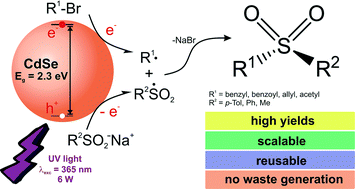Sulfonylation reactions photocatalyzed by quantum dots: rule of band-position and surface chemistry†
Abstract
An environmentally friendly methodology for the synthesis of different functionalized sulfones is described here. Quantum dots (QDs) of cysteamine (Cys) or 3-mercaptopropionic acid (MPA) capped cadmium chalcogenides (CdY, Y = S, Se, Te) were used as photocatalyst (UV, λ = 365 nm) for sulfonylation reactions. The reaction between benzyl bromide and sodium p-toluenesulfinate was used to determine the ideal experimental conditions, where CdSe–Cys presented the best photocatalytic activity, and the sulfonylation product was isolated in 4% to 92% yields. The optimized reaction conditions were then applied on reactions of benzyl, allyl, alkyl, aryl halides and α-bromoesters using different sodium salts of sulfinic acids and the products where obtained in a 57% to 99% yield range after 2 to 8 hours. A mechanism proposal involves the simultaneous reduction/oxidation of the reagents by the exciton generated by photoexcitation of the QDs. The photocatalytic activity of the QDs was estimated by analysis of the conduction/valence band energies and correlated with LUMO/HOMO energies of the reagents. Cyclic voltammetry was used as an analytical tool.



 Please wait while we load your content...
Please wait while we load your content...